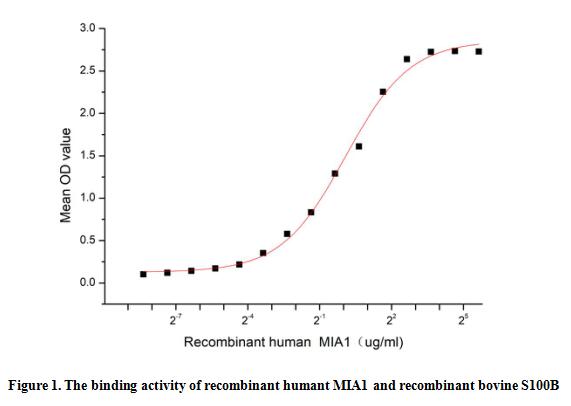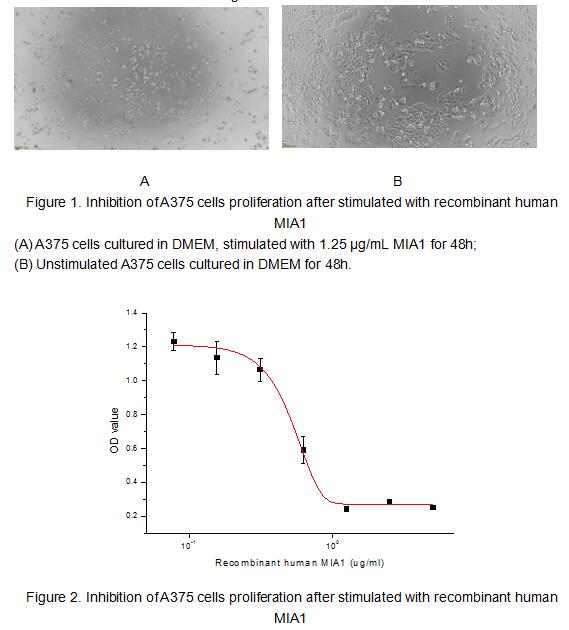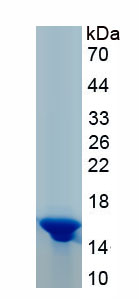Active Melanoma Inhibitory Activity Protein 1 (MIA1)
CD-RAP; Melanoma-derived growth regulatory protein
- Product No.APH650Hu01
- Organism SpeciesHomo sapiens (Human) Same name, Different species.
- Buffer FormulationPBS, pH7.4, containing 0.01% SKL, 5% Trehalose.
- Traits Freeze-dried powder
- Purity> 80%
- Isoelectric Point8.7
- ApplicationsCell culture; Activity Assays.
- DownloadInstruction Manual
- UOM 10µg50µg 200µg 1mg 5mg
- FOB
US$ 210
US$ 525
US$ 1050
US$ 3150
US$ 7875
For more details, please contact local distributors!
ACTIVITY TEST

Melanoma inhibitory activity (MIA), also known as cartilage-derived retinoic acid-sensitive protein (CD-RAP), is a 12-kDa protein that is secreted from both chondrocytes and malignant melanoma cells. MIA has been reported to have effects on cell growth and adhesion, and it may play a role in melanoma metastasis and cartilage development. In the presence of MIA, we observed enhanced migratory ability of melanocytic cells, induction of melanoma-associated genes as well as inhibition of apoptosis due to anoikis. S100 Calcium Binding Protein B (S100B) is a high affinity ligand for MIA1, a functional binding ELISA assay was conducted to detect the interaction of recombinant human MIA1 and recombinant bovine S100B. Briefly, MIA1 was diluted serially in PBS with 0.01% BSA (pH 7.4). Duplicate samples of 100 μl were then transferred to S100B-coated microtiter wells and incubated for 1h at 37℃. Wells were washed with PBST and incubated for 1h with anti-MIA1 pAb, then aspirated and washed 3 times. After incubation with HRP labelled secondary antibody for 1h at 37℃, wells were aspirated and washed 5 times. With the addition of substrate solution, wells were incubated 15-25 minutes at 37℃. Finally, add 50 µL stop solution to the wells and read at 450/630 nm immediately. The binding activity of recombinant humant MIA1 and recombinant bovine S100B was shown in Figure 1, the EC50 for this effect is 1.1 ug/mL.

To test the effect of MIA1 on cell apoptosis, A375 cells were seeded into triplicate wells of 96-well plates at a density of 4,000 cells/well and allowed to attach overnight, then the medium was replaced with various concentrations of recombinant human MIA1 diluted with 5% serum standard DMEM. After incubated for 48h, cells were observed by inverted microscope and cell viability was measured by Cell Counting Kit-8 (CCK-8). Briefly, 10 µl of CCK-8 solution was added to each well of the plate, then the absorbance at 450 nm was measured using a microplate reader after incubating the plate for 1-4 hours at 37 ℃. Apoptosis of A375 cells after incubation with MIA1 for 48h observed by inverted microscope was shown in Figure 1. Cell viability was assessed by CCK-8 assay after incubation with recombinant human MIA1 for 48h. The result was shown in Figure 2. It was obvious that MIA1 significantly decreased cell viability of A375 cells. The ED50 of recombinant human MIA1 is 0.53 ug/ml.
USAGE
Reconstitute in 10mM PBS (pH7.4) to a concentration of 0.1-1.0 mg/mL. Do not vortex.
STORAGE
Avoid repeated freeze/thaw cycles. Store at 2-8°C for one month. Aliquot and store at -80°C for 12 months.
STABILITY
The thermal stability is described by the loss rate. The loss rate was determined by accelerated thermal degradation test, that is, incubate the protein at 37°C for 48h, and no obvious degradation and precipitation were observed. The loss rate is less than 5% within the expiration date under appropriate storage condition.
GIVEAWAYS
INCREMENT SERVICES
-
 BCA Protein Quantification Kit
BCA Protein Quantification Kit
-
 Molecular Mass Marker for Protein
Molecular Mass Marker for Protein
-
 Monoclonal Antibody Customized Service
Monoclonal Antibody Customized Service
-
 Polyclonal Antibody Customized Service
Polyclonal Antibody Customized Service
-
 Protein Activity Test Experiment Service
Protein Activity Test Experiment Service
-
 Electrophoretic Mobility Shift Assay (EMSA) Experiment Service
Electrophoretic Mobility Shift Assay (EMSA) Experiment Service
-
 Buffer
Buffer
-
 Lentivirus Packaging Experiment Service
Lentivirus Packaging Experiment Service
-
 Adenovirus Packaging Experiment Service
Adenovirus Packaging Experiment Service
-
 Real Time PCR Experimental Service
Real Time PCR Experimental Service
-
 Spike RBD Protein (S-RBD)
Spike RBD Protein (S-RBD)
-
 Protein G
Protein G
-
 Protein A
Protein A
| Catalog No. | Related products for research use of Homo sapiens (Human) Organism species | Applications (RESEARCH USE ONLY!) |
| APH650Hu01 | Active Melanoma Inhibitory Activity Protein 1 (MIA1) | Cell culture; Activity Assays. |
| RPH650Hu01 | Recombinant Melanoma Inhibitory Activity Protein 1 (MIA1) | Positive Control; Immunogen; SDS-PAGE; WB. |
| PAH650Hu01 | Polyclonal Antibody to Melanoma Inhibitory Activity Protein 1 (MIA1) | WB; IHC; ICC; IP. |
| MAH650Hu21 | Monoclonal Antibody to Melanoma Inhibitory Activity Protein 1 (MIA1) | WB; IHC; ICC; IP. |
| SEH650Hu | ELISA Kit for Melanoma Inhibitory Activity Protein 1 (MIA1) | Enzyme-linked immunosorbent assay for Antigen Detection. |
| LMH650Hu | Multiplex Assay Kit for Melanoma Inhibitory Activity Protein 1 (MIA1) ,etc. by FLIA (Flow Luminescence Immunoassay) | FLIA Kit for Antigen Detection. |







